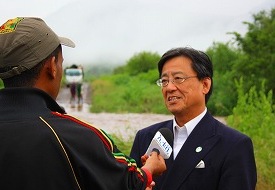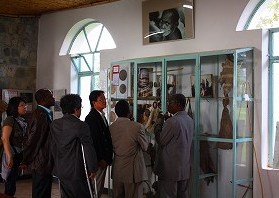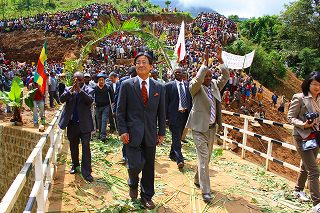|
 From 16 to 20 November 2011, Japanese Ambassador H.E. Mr. Hiroyuki Kishino led a delegation of the Ethiopian Press to visit seven Grassroots Human Security Projects (GGP) and one Enset Nursery Center in the Gamo Gofa and South Omo Zones of the SNNPRS. From 16 to 20 November 2011, Japanese Ambassador H.E. Mr. Hiroyuki Kishino led a delegation of the Ethiopian Press to visit seven Grassroots Human Security Projects (GGP) and one Enset Nursery Center in the Gamo Gofa and South Omo Zones of the SNNPRS.
In the Gamo Gofa Zone, Ambassador Kishino first conducted a visit to an Alternative Dispute Resolution (ADR) Center built with the assistance of the Embassy in 2009 in Arba Minch town at the cost of USD 35,000. The delegation was briefed by Ms. Haregewoyn Ashenafi, Director of Ethiopian Albiteration and Concilation Center (EACC). The delegation then visited the Gamo area High Court, and the Woreda and Kebele Arbitration courts where officials and elders explained the mediation process and how ADR Ethiopia integrates mediation of petty offences with local justice agencies. This eases the burden that would otherwise cost the community a lot in terms of money and time. Over the past 6 months, more than 650 cases have been resolved in 10 Kebeles. ADR Ethiopia has also built the same kind of mediation center in Bahir Dar with financial assistance from the Embassy of Japan.
 The next day, 17 November 2011, the delegation traveled to Jinka and visited the South Omo Research Center (SORC). The Jinka Museum, the Jinka Library, a store and guest rooms were built with the financial assistance of the Japanese Government at a cost of USD 95,632. The Jinka Museum hosts a mosaic of artifacts from the Mursi, Arri, Male and other ethnic groups. The library is a golden colour and is shaped in a letter J which is also reflected in the name of the library - the Nippon-Jinka Public Library [Nippon is a Japanese word for Japan, hence J to symbolize Japan and Jinka]. The next day, 17 November 2011, the delegation traveled to Jinka and visited the South Omo Research Center (SORC). The Jinka Museum, the Jinka Library, a store and guest rooms were built with the financial assistance of the Japanese Government at a cost of USD 95,632. The Jinka Museum hosts a mosaic of artifacts from the Mursi, Arri, Male and other ethnic groups. The library is a golden colour and is shaped in a letter J which is also reflected in the name of the library - the Nippon-Jinka Public Library [Nippon is a Japanese word for Japan, hence J to symbolize Japan and Jinka].
Student dormitories were also built with a total cost of USD 142,500. They accomodate more than 300 students who come to Jinka from the most remote and marginal areas. There are success stories of students who lived in the dormitory, and have now joined universities.
 On the third day of the Press Tour, H.E. Ambassador Kishino led the visiting delegation to one of the most deadly rivers, the Sala, over which Japan has supported the construction of a bridge for USD 106,323. In his remarks at the inauguration of the Sala River Bridge, H.E. Ambassador Kishino underlined the difficult journey his delegation had made from Jinka to Wubhamer, which is only 30 k.m. but consumed more than 3 hours. More than 26,000 people will be served by the Sala River Bridge, Ambassador Kishino said, stressing the importance of the bridge in connecting isolated communities on both sides of the river. This enables now the growth of local economies and improvement of social welfare. On the third day of the Press Tour, H.E. Ambassador Kishino led the visiting delegation to one of the most deadly rivers, the Sala, over which Japan has supported the construction of a bridge for USD 106,323. In his remarks at the inauguration of the Sala River Bridge, H.E. Ambassador Kishino underlined the difficult journey his delegation had made from Jinka to Wubhamer, which is only 30 k.m. but consumed more than 3 hours. More than 26,000 people will be served by the Sala River Bridge, Ambassador Kishino said, stressing the importance of the bridge in connecting isolated communities on both sides of the river. This enables now the growth of local economies and improvement of social welfare.
Over 10,000 people attended the inauguration programme. The Sala River is one of the major tributaries of the Omo River and has been the cause of trouble for centuries. It hindered the development of Wubhamer by isolating it from the most important links even though the town is older than Jinka. However, November 18 was a day of light for the citizens of Wubhamer. People were singing in harmony lauding the Ethio-Japan friendship. At one point the delight of the people reached a high point when a poet recited his poem, which according to one source translated as ‘goodbye River Sala, you will no more put our children and cattle at risk for we, together with the Japanese wrestled you down forever’.
The delegation then visited two more GGP projects (the Metser Primary School and Metser Farmers Training Center) and the Enset Nursery Center. South Omo is one of the places in Ethiopia where efficient clusters of GGP projects are situated and the spill-over effect of the philosophy of GGP scheme is effectively witnessed. To date, ten GGP projects with a total funding of USD 815,000 have been implemented in the South Omo Zone.
On 19 November, the fourth day of the tour, after traveling 27 k.m. the scheduled visit to the Maki Primary School was halted by unexpected flooding of the road that leads to the school. In the afternoon, His Excellency visited the Konso cultural landscape that UNESCO added to its World Heritage List in June 2011 and met King Kalla, the 20th reigning traditional King of Konso. King Kalla explained to Ambassador Kishino that Konso has its own cultural traditions stretching back 20 generations (400 years). Ambassador Kishino also visited the cemetery of the Konso royal family, which features anthropomorphic wooden statues.
On the last day of the tour, Ambassador Kishino paid a concluding visit to Arba Minch University (AMU). His Excellency was briefed by the University President and visited the library and different laboratories of AMU.
Professor Masayoshi Shigeta, who has been living and working for the past 25 years in the area and has played a significant role in initiating most of the GGP projects in the South Omo Zone, accompanied the Tour.
The media participating in the event were drawn from the Ethiopian Radio and Television Agency, Capital, the Ethiopian Herald, the Reporter and FM Sheger radio.
|
|



